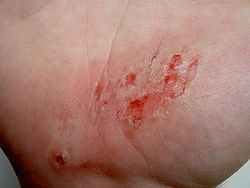This article needs additional citations for verification .(April 2023) |
| Abrasion (medical) | |
|---|---|
 | |
| Abrasion on the palm of a right hand, shortly after falling | |
| Specialty | Emergency medicine |
An abrasion is a partial thickness wound caused by damage to the skin. [1] It can be superficial, which involves only the epidermis, or deep, which involves the deep dermis. Abrasions usually involve minimal bleeding. [2] Mild abrasions, also known as grazes or scrapes, do not scar or bleed because the dermis is left intact, but deep abrasions that disrupt the normal dermal structures may lead to the formation of scar tissue. A more traumatic abrasion that removes all layers of skin is called an avulsion.
Contents
Abrasion injuries most commonly occur when exposed skin comes into moving contact with a rough surface, causing a grinding or rubbing away of the upper layers of the epidermis.










